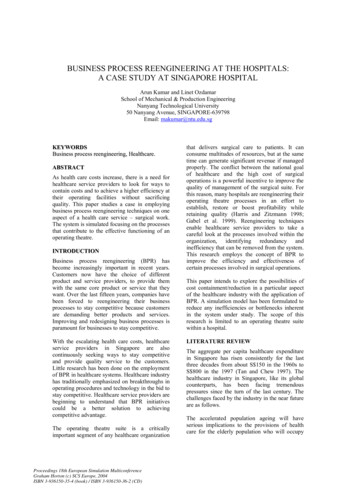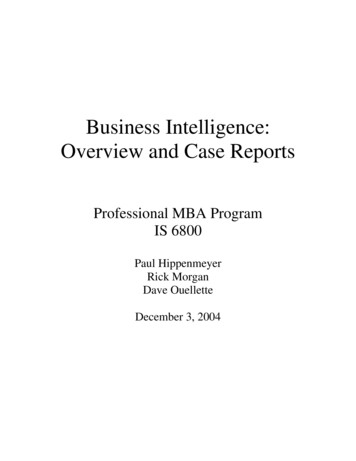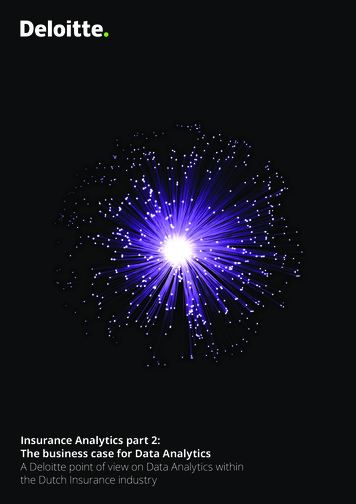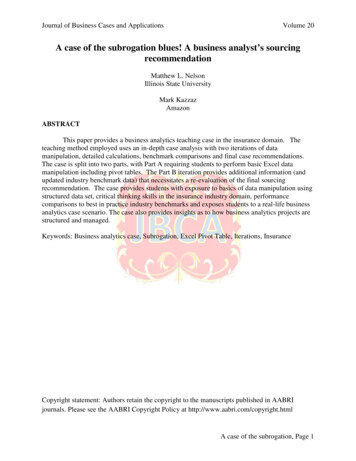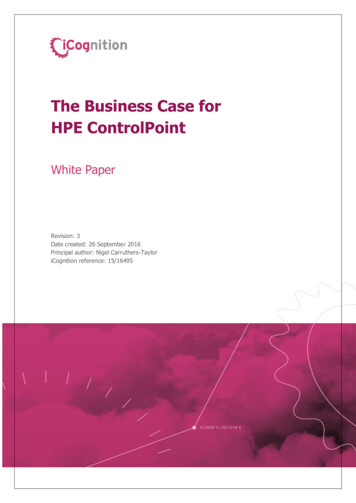
Transcription
The Business Case forHPE ControlPointWhite PaperRevision: 3Date created: 26 September 2016Principal author: Nigel Carruthers-TayloriCognition reference: 15/16495
Executive SummaryTable of ContentsExecutive Summary . 3Business Case for HPE ControlPoint . 5A Digital Recordkeeping Platform . 5Digital recordkeeping is the core . 7Products to supply the Platform . 8HPE ControlPoint Cost/Benefit . 11Summary . 11Details . 12The Business Case for HPE ControlPointPage 2 of 18
Executive SummaryExecutive SummaryBased on an organisation of 1500 staff and around 25Tb of information in targetrepositories, and using a conservative estimation, the implementation of HPE ControlPointproduces a significantly positive 5 year cost-benefit of 1.7M, a Net Present Value (NPV) of 1.5M, and a benefit-cost ratio of 4.15.Discount RateNPVPV of Total CostsPV of Total Benefits4%8%10% 1,527,232 1,330,071 1,244,290- 484,776- 452,796- 438,399 2,012,008 1,782,867 1,682,6894.153.943.84Benefit Cost RatioCosts: Software licencesSetup and maintenance of softwareQuantifiable benefits: Storage savings of 343K over 5 yearsDiscovery/Freedom of Information (FOI) savings of 1.9M over 5 yearsNon-quantifiable benefits: Managing security and privacy informationIncreased productivity for end usersCompliance and regulation risk avoidance.Digital information in most organisations is distributed across multiple repositories. Only about30% of this has business value, but the ability to identify and harness this value is difficult.This also means 70% is redundant, trivial and obsolete information that carries a significantcost to store and manage.To manage this, a strategy to implement ‘trusted sources’ ofinformation underpinned by a digital recordkeeping platform isrecommended.A digital recordkeeping platform identifies records across multiple information repositories,such as file stores, email, SharePoint and email, and either manages them as records withinthese repositories, or migrates them into a central records repository.The Business Case for HPE ControlPointPage 3 of 18
Executive SummaryThis central records repository is a digital recordkeeping solution that assists users to savedocuments (including emails) directly to it, and also has automated processes to managerecords of high business value stored in other systems. HPE Records Manager/ContentManager (HPE RM/CM) is such a solution that links to a number of business systems orinformation repositories to form an overall Digital Recordkeeping Platform.HPE ControlPoint links to HPE Records Manager/Content Manager tomanage and control records across multiple repositories. It analysesthe information environment, assesses the value of the information,finds security related information, controls records through policy, andharnesses the information for reuse.While there may be a number of products that make up the Digital Recordkeeping Platform, inthis analysis only the HPE ControlPoint product is analysed to determine the product’sindividual cost-benefit.The Business Case for HPE ControlPointPage 4 of 18
Business Case for HPE ControlPointBusiness Case for HPE ControlPointA Digital Recordkeeping PlatformMost organisations have an information management environment where information of allforms is managed in a variety of silos and formats: recordkeeping systems, personal andshared network drives, SharePoint, email, Financial and HR systems, and line-of-businesssystems.Digital information in most organisations is distributed across multiplerepositories. Only about 30% of this has business value, but the abilityto identify and harness this value is difficult.The US Compliance, Governance and Oversight Counsel (CGOC) conducted a survey in 2012that revealed on average 1% of organizational data is subject to legal hold, 5% is subject togovernmental regulatory retention requirements, and 25% has some business value. Thismeans that around 31% of the existing information held in file stores, email systems, andother line-of-business systems could be considered records of true value.If these records are not identified, managed and accessible, then the true value of thisinformation cannot be harnessed. Not only is this a productivity loss, but discovering andmanaging these true records is a difficult problem that can carry significant cost. Further tothis, there are critical security and privacy risks in some of this information, such asuncontrolled Tax File Numbers, credit card numbers, personal details and passwords, thatorganisations need to manage to meet compliance and regulation requirements.This also means 70% is redundant, trivial and obsolete informationthat carries a significant cost to store and manage.The flip side to this issue is that the 2012 CGOC Study pointed out that the remaining 69% ofthe enterprise’s information is redundant, obsolete and trivial information that carries asignificant cost in storage and productivity. The Study concluded that this information couldbe defensibly deleted without adversely affecting the organization, thus reducing the overalldigital storage footprint significantly and producing storage savings.A digital recordkeeping platform is recommended to identify, sanitise,manage and migrate records across multiple information repositories,including file stores, email, SharePoint and email.In this dynamic environment there is often an organisational culture where staff have afreedom of choice when it comes to using systems and storing information. Therefore it isThe Business Case for HPE ControlPointPage 5 of 18
Business Case for HPE ControlPointvery difficult for organisations to replace all information repositories with an enterprise-wideEnterprise Content Management (ECM) or Electronic Document and Record ManagementSystem (EDRMS). Instead, a digital recordkeeping ‘platform’ can be implemented to provideECM/EDRMS functions in targeted areas, and also be used to identify, link and managerecords in key repositories across the environment.This fully implemented Digital Recordkeeping Platform would be a vehicle for delivering anexciting change within the information environment and transition the organisation to digitalrecordkeeping. It can deliver ‘trusted sources of information’ within the organisation, which iswhere Business Information Systems are identified as ‘trusted sources’ for managing particularinformation types underpinned by the Digital Recordkeeping Platform. Each ‘trusted source’would manage the identified key information stored within it using records compliance lifecycles.This will allow the creation of ‘trusted sources’ of information,underpinned by the digital recordkeeping platform.All trusted sources can then be governed by this platform, bringing the trusted sourcestogether into an information management and governance framework. The platform wouldenable the migration and/or capture of digital records from these sources into therecordkeeping system, or the application of in-place recordkeeping policies to the informationin its existing repository. These elements would be brought together as a platform wheredigital recordkeeping services are accessed across an integration layer within the ITenvironment.This Digital Recordkeeping Platform, as shown in Figure 1, can be expanded to include thecapture of records from business processes or from various presentation interfaces, whetherthat be desktop, web, collaborative workspace, or mobile device. Therefore it is a multilayered platform that includes the services layer, an integration layer, a business processlayer, and the presentation layer. At each layer several products or components may exist.The Business Case for HPE ControlPointPage 6 of 18
Business Case for HPE ControlPointFigure 1: Digital Recordkeeping PlatformDigital recordkeeping is the coreThe core solution would assist users to save documents (includingemails) directly to it and become a central repository of high valuebusiness information that meets recordkeeping requirements.The core solution would be a digital recordkeeping solution that, out-of-the-box, providesusers with the ability to share and access information securely. The digital recordkeepingsolution could provide an enterprise system that underpins the day-to-day applications usedby staff, transparently capturing and managing digital objects. The digital recordkeepingsolution would then assist users to save information directly to it and become a centralrepository of controlled and managed documents (including emails) that meets recordkeepingrequirements.The digital recordkeeping solution would enable the management of documents and filesregardless of their format or storage location. This would include all forms of electronicdocuments created via email, word processing applications, scanned documents and paperfiles.The Business Case for HPE ControlPointPage 7 of 18
Business Case for HPE ControlPointAdditionally, hardcopy records can be managed through a combination of file requests andusing scanning technologies to convert paper-based information into digital forms. Onceconverted into digital form the paper based copy can be legally disposed. The end goal wouldbe to remove the use of all hardcopy files.Integrating or underpinning corporate applications with the digitalrecordkeeping platform would provide a means for transparentlyclassifying, sanitising and sentencing data in those applications.The solution is then expanded to form the Digital Recordkeeping Platform that provides ameans for transparently classifying, sanitising and sentencing data from both existing andfuture corporate systems, and subsequently managing its timely destruction. This allows vitalsystems such as HR, Finance and email systems, which do not have a native recordsmanagement capability, to capture, manage and control records within it, thus making themcomply to ISO16175 Principles and Functional Requirements for Records in Electronic OfficeEnvironments.Products to supply the PlatformHPE Records Manager/Content Manager is a strong product that can provide the required coredigital recordkeeping solution. It is well supported in the Australian and New Zealand markets,and links to a range of information governance products to provide the Digital RecordkeepingPlatform described above.Industry analysts Gartner and Forrester conclude that HPE Records Manager/Content Manageris a leader in the ECM market1. ECM is a superset of EDRMS, and includes technologies suchas web publishing and scanning. In Australia HPE RM/CM is the most prevalent ECM solution,occupying 75% of the Federal Government market, around 40-55% of the State Governmentmarket, and similar for local governments2. The product also has good private organisationcoverage, and is prevalent in the superannuation, education, and not-for-profit sectors.Gartner Magic Quadrant for Enterprise Content Management , September 2015 and TheForrester Wave: Enterprise Content Management, Q3 201312iCognition survey for Department of Communications, 2015The Business Case for HPE ControlPointPage 8 of 18
Business Case for HPE ControlPointHPE Records Manager/Content Manager links a number of modules orproducts that can help form the overall Digital RecordkeepingPlatform.To complete the Digital Recordkeeping Platform, the following additional products could addedto the Integration Layer:HPE ControlPoint links to HPE Records Manager/Content Manager tomanage and control records across multiple repositories. It cananalyse the information environment, assess the value of theinformation, control it as records, and harness it for reuse. HPE ControlPoint: can be used to analyse an information environment, assess thevalue of information through identification and classification, identify security andprivacy related information (e.g. TFN, credit card details, personal information andpasswords), and then improve the information environment by removing redundant,obsolete and trivial information, migrating vital information to HPE RecordsManager/Content Manager, and/or linking information in-place to HPE RecordsManager/Content Manager to apply records management compliance. The productcomes with out-of-the-box integrations to SharePoint, Exchange, File Stores, iManageand HPE Records Manager/Content Manager, and a beta version of a Documentumintegration exists. HP Structured Data Manager: can automate information lifecycle managementand structured data optimization by relocating inactive data from expensive tier 1production systems and legacy databases to HPE Records Manager/Content Manager.This enables organisations to retire outdated applications through an automatedprocess of extracting, validating, and deleting data. RM Connector: allows multiple line-of-business systems to be linked to HPE RecordsManager/Content Manager to facilitate automated capture, and then exposing ofthose records back into the line-of-business systems to allow easy and direct accessto records.In this analysis only the HPE ControlPoint product is analysed todetermine the product’s individual cost-benefit.Figure 2 shows how these products form the Digital Recordkeeping Platform.The Business Case for HPE ControlPointPage 9 of 18
Business Case for HPE ControlPointFigure 2: Products to form the Digital Recordkeeping PlatformThe Business Case for HPE ControlPointPage 10 of 18
HPE ControlPoint Cost/BenefitHPE ControlPoint Cost/BenefitSummaryBased on an organisation of 1500 staff and around 25Tb of information in targetrepositories, and using a conservative estimation, the implementation of HPE ControlPointproduces a significantly positive 5 year cost-benefit of 1.7M, a Net Present Value (NPV) of 1.5M, and a benefit-cost ratio of 4.15.Discount Rate3NPV4PV of Total CostsPV of Total Benefits4%8%10% 1,527,232 1,330,071 1,244,290- 484,776- 452,796- 438,399 2,012,008 1,782,867 1,682,6894.153.943.84Benefit Cost RatioCosts: Software licencesSetup and maintenance of softwareQuantifiable benefits: Storage savings of 343K over 5 years5Discovery/FOI savings of 1.9M over 5 years5Non-quantifiable benefits: Managing security and privacy informationIncreased productivity for end usersCompliance and regulation risk avoidance.The discount rate reflects the opportunity cost of capital, i.e. the return on capitalforegone in alternative use of the resources.34The benefits and costs are analysed to a Present Value (PV), i.e. the value on a givendate of a series of future payments, discounted to reflect the time value of money andother factors such as investment risk. Net Present Value (NPV) is the sum of the values ofthe discounted cash flows.5Based on industry wide standard estimates, conservatively reduced and skewed over fiveyears.The Business Case for HPE ControlPointPage 11 of 18
HPE ControlPoint Cost/BenefitDetailsSolutionHPE ControlPoint expands a digital recordkeeping strategy enterprise wide to provide asubstantial part of the digital recordkeeping platform discussed in the first section of thisWhite Paper. This product is assumed to be an addition to the core digital recordkeepingsolution, HPE Records Manager/Content Manager, to provide a wider platform to: identify records in other information systems or repositories;place and enact recordkeeping policies on records held in other repositories;migrate identified records into a shared recordkeeping platform where suitable.HPE ControlPoint links to HPE Records Manager/Content Manager out of the box to manageand control records across multiple repositories, including SharePoint, Exchange, File Stores,iManage and HPE Records Manager/Content Manager, and a beta version of a Documentumintegration exists. ControlPoint can be used to analyse the information environment, assessthe value of the information, identify security and privacy related information (e.g. TFN, creditcard details, personal information and passwords), and improve the information environmentby migrating vital information to HPE Records Manager/Content Manager, and/or linkinginformation in-place to HPE Records Manager/Content Manager to better meet recordsmanagement compliance and manage information in-place as a vital corporate asset.Key AssumptionsThe following assumptions are made in this analysis: The organisation is assumed to have 1500 staff and have 25Tb of information intarget repositories.Only three major discovery exercises are required per year, consisting of an initialcollection of 3.5Gb of data per custodian, 23 custodians assumed, totalling 80.5 GBtotal.The discovery savings are assumed to be conservatively achieved over a period of fiveyears, starting at 40% in Year 1, and climbing to 80% in Year 5.Storage saving are estimated on a conservative defensible disposal reduction factor of40% and a deduplication factor of 15%—meaning 15% of the stored content will beduplicate files and easily disposed of. Between these two reduction factors, aconservative estimate of 55% reduction in stored files is assumed to occur over a fiveyear period.Quantifiable BenefitsDefensibly disposing the Redundant, Obsolete and Trivial (ROT)information from enterprise repositories conservatively removes 55%The Business Case for HPE ControlPointPage 12 of 18
HPE ControlPoint Cost/Benefitof the stored information over a five year period. At 25/Gb, this canbe a significant saving.1. Storage SavingsThe solution can be implemented to discover and manage records of value in existing filesstores, email, and systems such as SharePoint and email. These records can be eithermigrated into HPE RM/CM, or managed in place by applying policies to the records. Theremainder of the information can be defensibly deleted, giving rise to significant storagesavings.To calculate the estimated storage saving, a conservative defensible disposal reductionfactor of 40% and a deduplication factor of 15%—meaning 15% of the stored content willbe duplicate files and easily disposed of. Between these two reduction factors, aconservative estimate of 55% reduction in stored files is assumed to occur over a fiveyear period.According to an Osterman Research White Paper, The True ROI of InformationGovernance, published February 2015, the true cost of managing tier 1 storage at 25/Gbper year. This includes the cost of raw storage; as well as the additional costs ofperformance tiers, floor space, power/cooling, and the cost of backup and disasterrecovery, etc.2. Discovery/FOI SavingsAgreed ‘trusted sources’ of digital records can be established,minimising ephemeral information and making the task of locating thecorrect, trusted record much easier and faster.The identification of records across these information repositories will facilitate faster andmore targeted responses to discovery requests. This cost can be quantified, calculated onless information to search and review, faster and better search mechanisms, fasterretrieval and access to information, as well as speeding up review processes throughautomatic categorisation and reduced time to assemble a responsive collection.Discovery, including FOI searches, is dependent on the collection of all potentially
The Business Case for HPE ControlPoint Page 3 of 18 Executive Summary Based on an organisation of 1500 staff and around 25Tb of information in target repositories, and using a conservative estimation, the implementation of HPE ControlPoint produces a significantly positive 5







